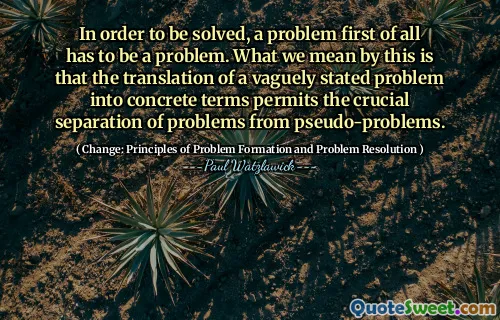
In order to be solved, a problem first of all has to be a problem. What we mean by this is that the translation of a vaguely stated problem into concrete terms permits the crucial separation of problems from pseudo-problems.
Understanding problems is a fundamental step in effective problem-solving, and this quote highlights the importance of properly identifying and defining problems before attempting to address them. Often, what appears to be a complex or daunting issue can be a misinterpretation or a vague perception that, once clarified, reveals itself as a much simpler challenge. The process of translating a vague or ill-defined problem into precise, concrete terms enables us to discern whether we are truly facing a real issue or merely a pseudo-problem that bears no real significance or impact. This act of refinement avoids wasting time, effort, and resources on superficial concerns that might seem problematic due to misunderstandings or incomplete information. It is analogous to peeling layers of an onion to reach the core core of the matter. When problems are clearly articulated, they are easier to analyze, strategize, and ultimately resolve with confidence. Furthermore, this approach encourages critical thinking and promotes a mindset that questions assumptions, tests hypotheses, and seeks clarity. Clarity in problem definition also aligns with effective communication, as it ensures all stakeholders share a common understanding. As a result, problem-solving becomes more efficient, targeted, and productive. This quote from Watzlawick emphasizes that addressing real problems accurately is often more about the correct framing than about the complexity of solutions. In essence, proper problem identification serves as the foundation upon which successful solutions can be built, echoing a universal principle in many fields including therapy, management, engineering, and daily life. Recognizing the difference between genuine and pseudo-problems is a skill that can save individuals and organizations from unnecessary complexity and foster a more focused approach to overcoming challenges.






